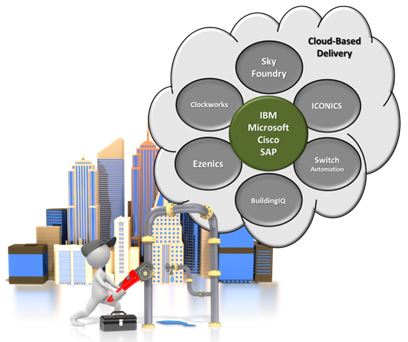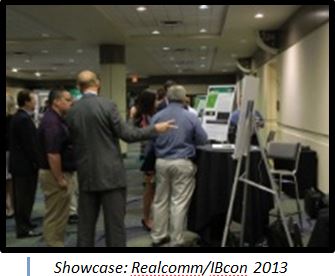|
July 2013
Article
AutomatedBuildings.com
|
[an error occurred while processing this directive]
(Click
Message to Learn More)
|
The
message I received, as well as countless others I spoke with, was loud
and clear – cloud-based computing, open architecture, data analytics,
visualization, and mobility will forever be a required participant in
high performance buildings.
|
|
In celebrating its
15th year as a premier conference serving the real
estate and intelligent buildings sectors, Realcomm/IBcon 2013 was a
watershed moment for the organization. Not only did the business
achieve a significant milestone in influencing the commercial real
estate industry through technology awareness, they also removed any
doubt that “convergence” is
here to stay. The general acceptance of
cloud-based computing, open architecture, data analytics,
visualization, and mobility will forever be a required participant in
our industry. Fortunately, it appears that the days of proprietary
“products” are coming to an end.
Although
Realcomm and IBcon are marketed as one event, they actually
focus on two different segments, Realcomm targets the commercial real
estate industry and IBcon focuses on intelligent building technologies.
For purposes of this observation, we are going to center on IBcon. Even
though IBcon is a new entrant in the intelligent buildings conference
series (2nd year), it is nevertheless, regarded as one of the leaders
in providing insight into smart building innovation.
Jim
Young’s (Realcomm/IBcon CEO) vision of a REvolution
— a point in
time where things will change so radically that there is no turning
back to the old ways, appears to be spot on as it relates to this
sector.
 The “new” REvolution will be more than
televised, as evidenced the
second you walked through the conference doors. The peculiar absence of
Johnson Controls, Siemens, Schneider, United Technologies, Trane and
Honeywell (other than a booth to showcase thermostats and cable wraps)
was immediately noticeable. Tridium was the only organization from that
sector that brought a large presence to the show.
The “new” REvolution will be more than
televised, as evidenced the
second you walked through the conference doors. The peculiar absence of
Johnson Controls, Siemens, Schneider, United Technologies, Trane and
Honeywell (other than a booth to showcase thermostats and cable wraps)
was immediately noticeable. Tridium was the only organization from that
sector that brought a large presence to the show.
If
Tridium’s new President, Nino DiCosmo, is any indication of the
business’s commitment to leadership, I think they got it right. DiCosmo
has 20+ years in the enterprise software industry. His view of this
market and Tridium’s ability to uniquely impact its addressable
customer-base, is more aligned with the vision Young paints than any
other competing solution.
Nevertheless, what makes this observation interesting is that fact that
if the enterprise software industry was holding its leading conference
on thought leadership, you could bet your bottom dollar the likes of
Microsoft, SAP, Oracle, IBM and Cisco would certainly be there in
numbers.
Whatever the reason the big automation
players within our industry
decided not to show a “leading” presence, emerging players such as
Microsoft, SAP and IBM sure did. The Microsoft campus case study still
remains one of the leading examples of the transformation that is
taking place in our industry. Mention Darrell Smith of Microsoft and
everyone knows who Darrell is. Question: who’s leading JCI’s
intelligent buildings initiative, or Siemens, Honeywell? I have no idea
as they sure weren’t at the show.
IBM’s
attendance was very visible at the conference as well. Niall
Brady, IBM’s Senior R&D Engineer, provided a look into IBM’s
smarter buildings research and development efforts which illustrated
the commitment and investment the business is making in this industry.
Furthermore, the IBM GSA case study was widely viewed during the
showcase. Johnny Clemmons from SAP demonstrated thought leadership
during panel discussions, and Oracle also had a booth and made
themselves visible as well.
Furthermore,
countless clean tech solutions (ISVs & Professional
Services) were driving the innovation curve throughout the two day
event. SkyFoundry, ICONICS, Clockworks, Ezenics, Switch Automation,
JLL’s Intellicommand, DGLogik, Environmental Systems (ESI), and many
others provided undisputable evidence that the REvolution is indeed
upon us.
 Acting like a telescope, IBcon
provides visibility for where the market
is headed. If you look hard enough, you can see the development of a
new “industry architecture” beginning to take shape. It appears this
emerging force is relegating the “legacy” automation players to the
role of simply providing “plumbing.”
Acting like a telescope, IBcon
provides visibility for where the market
is headed. If you look hard enough, you can see the development of a
new “industry architecture” beginning to take shape. It appears this
emerging force is relegating the “legacy” automation players to the
role of simply providing “plumbing.”
Their
hardware/services act as a data pump which allows the clean tech
providers to expose their results to the enterprise software companies,
who in turn, surface “business value” to the organization’s leaders to
make more informed “systemic” decisions regarding their real estate
portfolio. It will be very interesting to see the investment patterns
emerging from the largest software companies as they fight to capture
the last bastion of the enterprise (the building).
 Not
only was there quality information available throughout the exhibit
hall, the Smart Building Best
Practice Showcase had to be one of the
most effective sessions I’ve come across at a conference. There were 30
case studies on display along with representatives who walked you
through the engagement from the business opportunity, the solution, to
the results that were attained.
Not
only was there quality information available throughout the exhibit
hall, the Smart Building Best
Practice Showcase had to be one of the
most effective sessions I’ve come across at a conference. There were 30
case studies on display along with representatives who walked you
through the engagement from the business opportunity, the solution, to
the results that were attained.
The
format was not only diverse and informative; it was a great
networking experience as well. Actually, it was probably the most
impactful session of the two days.
In
terms of the breakout sessions themselves, there were many
worthwhile tracks to attend - from Building Cybersecurity, Building
Network Design, NextGen FM Team to Extreme Operations – Connecting
Everything to the Network. The general feedback was that the mix of
single speaker presentations and panel discussions was balanced and
effective. Furthermore, I heard numerous comments that both the
speakers and panelists were successful in conveying their message.
[an error occurred while processing this directive]One
of the most talked about tracks was the PRE-CON IB Boot Camp. The
five hour program was designed for those organizations interested in
converting their existing buildings to smart, connected,
high-performance, intelligent buildings. The word was that the return
was substantial. The information provided by the panel of experts
apparently achieved its objective of empowering the attendees with good
industry information to act on.
Another highlight of the event was the Digie Awards. This
annual challenge which highlights top performers throughout the
industry, from Best Real Estate Technology to Most Intelligent Building
Award, is not only entertaining; it’s also pushing the industry
forward. This year’s winners included Kohl’s for Most Intelligent
Building – Retail, Microsoft for Most Intelligent Building – Corporate
Campus, Project Haystack for Best Intelligent Building – Technology
Innovation, Paul Oswald for Intelligent Building – Digital Impact
Award, as well as many other deserving providers of industry solutions.
 However, there is one component of the event that is in need of
improvement. My observation is not just limited to Realcomm/IBcon
though; it also applies to every conference I’ve attended in the
intelligent buildings sector for the past five years… Exhibits!
However, there is one component of the event that is in need of
improvement. My observation is not just limited to Realcomm/IBcon
though; it also applies to every conference I’ve attended in the
intelligent buildings sector for the past five years… Exhibits!
I
think we’d all agree that technology has evolved so fast during that
period; it has almost forced a much needed “REvolution” regarding the
practice of exhibiting. Everyone I spoke with who had a booth felt that
“relevant” traffic could be improved and more networking opportunities
would help increase the overall value of the event. There has to be a
way to maximize both the investment and the return so all parties feel
the value is there.
Nevertheless
in the end, the event was successful in driving the vision
of REvolution home
(a point in time where things will
change so
radically that there is no turning back to the old ways). The
message I
received, as well as countless others I spoke with, was loud and clear
– cloud-based computing, open architecture, data analytics,
visualization, and mobility will forever be a required participant in
high performance buildings.
footer
[an error occurred while processing this directive]
[Click Banner To Learn More]
[Home Page] [The
Automator] [About] [Subscribe
] [Contact
Us]